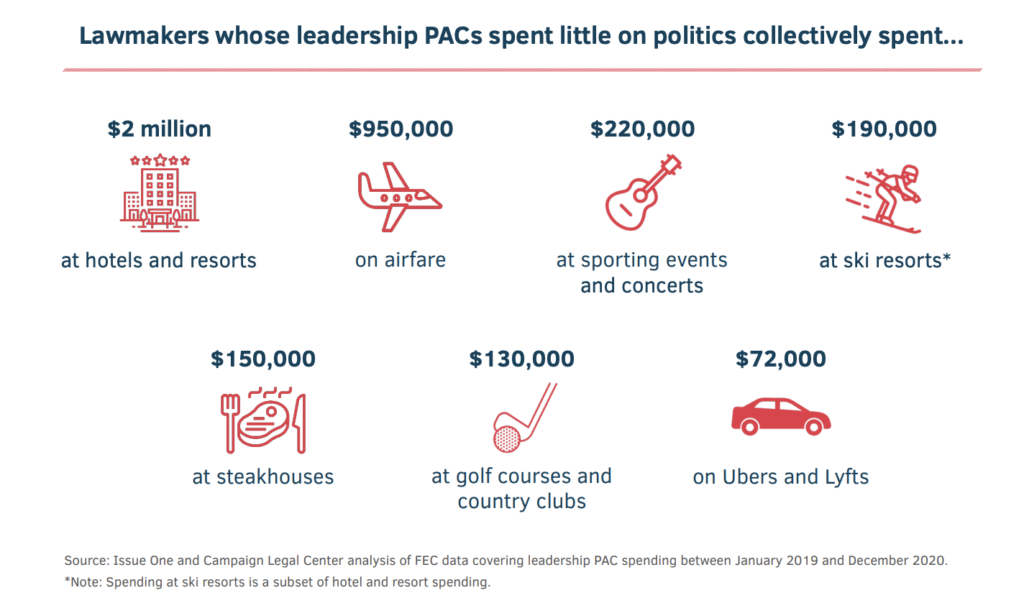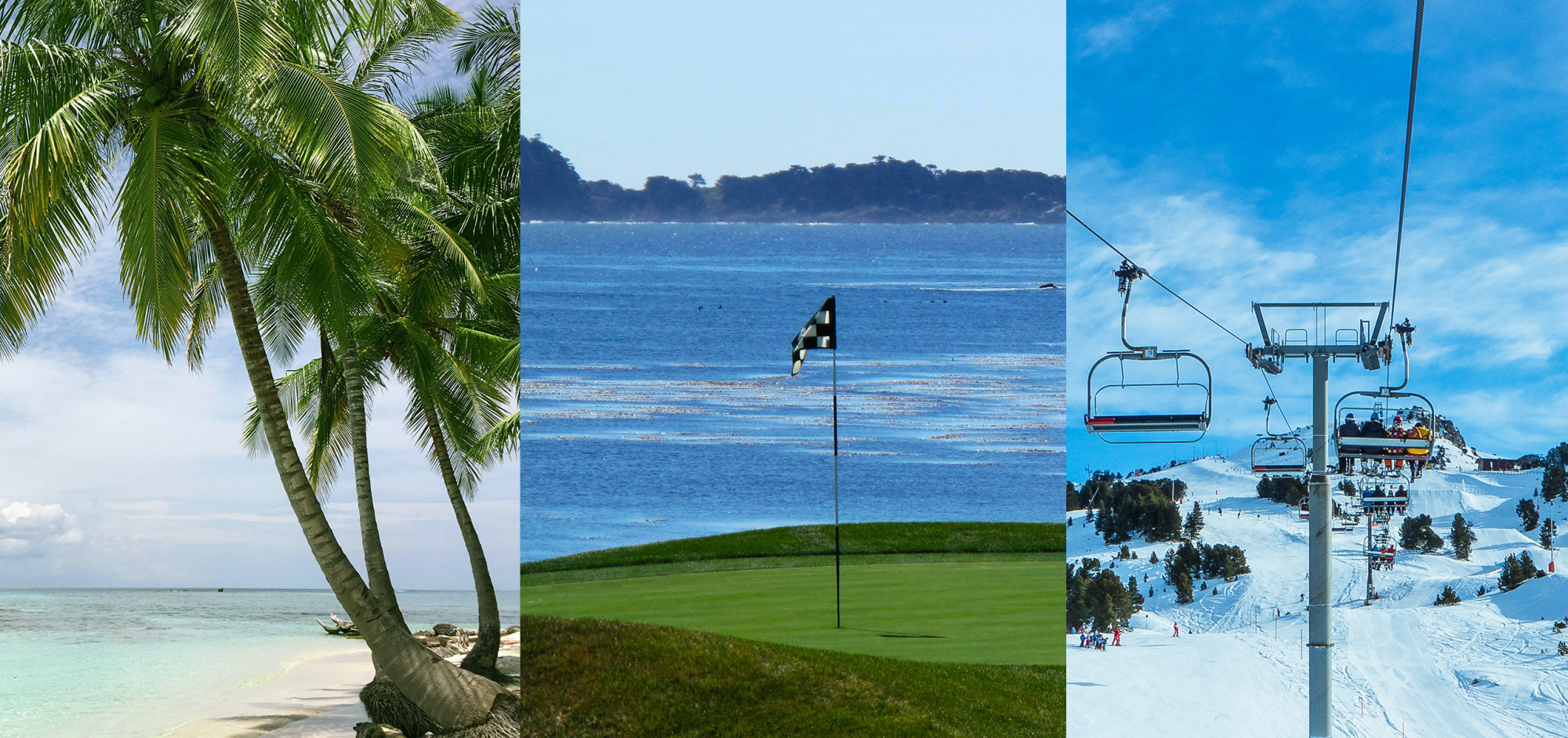
In 1978, Rep. Henry Waxman (D-CA), in coordination with powerful allies in California’s Democratic Party, asked the Federal Election Commission (FEC) to allow for the creation of “leadership PAC” accounts that would be separate from the authorized campaign committees that candidates use to run for Congress.
These new accounts would allow politicians to raise money and give it away to political allies and like-minded candidates, such as vulnerable colleagues or candidates running in competitive House and Senate races.
The FEC approved of Waxman’s request, and made clear that leadership PAC funds could not be used to pay for lawmakers’ re-election campaign expenses.
Today, leadership PACs are not just used by those in leadership roles. Indeed, 92% of members of Congress have them. And while most members of Congress primarily use their leadership PACs to make political contributions, new research from Issue One and Campaign Legal Center shows that scores of lawmakers are not, in fact, using the bulk of the money they raise in their leadership PACs to assist other candidates, their parties, or other political groups.
Issue One and Campaign Legal Center found that the leadership PACs of 120 members of Congress spent less than 50% on politics between January 2019 and December 2020. Moreover, 43 members of Congress spent less than 25% on politics during this time. And a handful spent at least five figures without ever contributing a penny to any local, state, or federal candidates, parties, or political groups. In contrast, during the same period, the typical member of Congress’ leadership PAC spent 70% on politics.
This report shines a light on the shocking reality that far too many politicians appear to be amassing money from special interests in their leadership PACs and then using that cash to enjoy perks of lavish living that are beyond the reach of most Americans — such as meals at fancy restaurants, trips to elite resorts, rounds of golf at premier courses, and more.
While such spending is purportedly done for the purpose of political fundraising, this explanation rings hollow when just a fraction of the money raised goes toward political contributions. Instead, such spending patterns give the impression that some politicians are simply raising money at one posh location to pay for the next fundraiser at the next fancy destination — creating an endless fundraising cycle at luxurious restaurants and resorts, much of which is paid for by special interest money, with no cost to lawmakers’ own pocketbooks.
When leadership PACs are essentially underwriting lavish lifestyles for politicians, it raises serious questions about whether leadership PAC funds are being spent in ways that amount to personal use. These questions could be answered by the FEC and Congress.
These questions could be answered by the FEC and Congress.
In 2018, Issue One and Campaign Legal Center submitted a rulemaking petition to the FEC, asking the commission to clarify the regulations of the personal use of leadership PAC funds. The petition remains pending.
For its part, Congress would simply need to make minimal revisions to existing language to confirm that the personal use ban does, in fact, apply to leadership PACs.
“When leadership PACs are essentially underwriting lavish lifestyles for politicians, it raises serious questions about whether leadership PAC funds are being spent in ways that amount to personal use.
Waxman — who has since retired from Congress after a long career as an influential legislator — last year told Issue One that he never imagined that leadership PACs would be so frequently used as slush funds, calling the abuse of leadership PACs a “loophole that ought to be closed.”
Issue One and Campaign Legal Center agree. It is past time for Congress to act.
Who spends little on politics?
For this investigation, Issue One and Campaign Legal Center scoured tens of thousands of campaign finance records, examining where leadership PAC funds were flowing, if not toward contributions to local, state, and federal candidates, political parties, and political groups.
Here are eight notable examples of officeholders in the 116th Congress — four Democrats and four Republicans — who spent only small portions of their leadership PAC cash on politics between January 2019 and December 2020. They are listed in order of the portion of their leadership PAC spending that was on politics.
Rep. George Holding (R-NC) — 2% on politics
Holding’s leadership PAC spent roughly $202,000 during this two-year period, with just 2% of its spending aiding other candidates, political parties, and political groups.
Where did the rest of the money go? The bulk of Holding’s leadership PAC spending went toward airfare, restaurants, hotels, car services, and exclusive members-only clubs in the United States and abroad.
Holding’s leadership PAC paid $22,000 to commercial airlines and another $12,000 to Uber. It also spent nearly $15,000 in London throughout 2019 and early 2020, including almost $11,000 at the East India Club, a private, men-only club.
And the United Kingdom was not the only place Holding was enjoying the perks of exclusive clubs.
Holding’s leadership PAC spent close to $9,000 over six occasions at the Union Club in New York City — the fifth-oldest private social club in the United States and the oldest in New York City.
And it spent $4,000 for food and beverages over 10 occasions at the 116 Club in Washington, D.C., a members-only establishment at which lawmakers and lobbyists routinely mingle.
Rep. Seth Moulton (D-MA) — 8% on politics
Moulton’s two leadership PACs combined to spend roughly $1.7 million during this two-year period, with just 8% of their spending aiding other candidates, political parties, and political groups.
While most of this spending went toward consultants, salaries, and administrative expenses, Moulton’s leadership PAC also footed sizable bills for transportation, lodging, and meals.
For instance, Moulton’s leadership PACs spent roughly $20,000 on meals, food, and catering, including $3,200 in March 2020 at the East Pole, an upscale farm-to-table restaurant in New York City, and $350 at Proxi, a high-end small plates restaurant in Chicago.
Moulton’s leadership PACs also spent $9,200 on airfare, and paid $1,200 to Uber for transportation. Additionally, his leadership PACs spent $2,100 on lodging at an assortment of hotels across the country, including $540 at a Canopy by Hilton in Washington, D.C., in the glitzy, waterfront Wharf neighborhood.
Sen. Rand Paul (R-KY) — 12% on politics
Just 12% of the roughly $990,000 Paul’s leadership PAC spent during this two-year period went toward contributions to other candidates, political parties, or political groups — the smallest percentage of any senator that did not retire in 2020.
All the while, Paul’s leadership PAC spent significant sums on dining, lodging, and transportation.
For instance, it spent $23,000 on airfare during this period, $18,000 on Uber rides, and $4,000 on Amtrak train tickets.
Furthermore, Paul made a habit of staying at luxury hotels on his leadership PAC’s tab — spending a total of $14,000 on lodging during this two-year period. Among the destinations were several of the top resorts in the country, including:
- $1,900 at The Breakers, a five-star resort in Palm Beach, Florida, which Fodor’s describes as “a legendary 140-acre self-contained jewel of a resort.”
- $1,500 at the Inn at Perry Cabin in St. Michaels, Maryland, which U.S. News and World Report has rated as the No. 1 resort in Maryland.
- $760 at the Salamander Resort, a luxury resort and spa in Middleburg, Virginia.
- $710 at Chateau Elan, which calls itself “North Georgia’s premier destination resort.”
Additionally, Paul’s leadership PAC spent $2,300 for expenses associated with golf courses and country clubs. These included a $600 payment to a golf instructor, $620 for registration fees at the Kelly Plantation Golf Club in Florida, and $680 in expenditures over multiple trips to the Trump National Golf Club in northern Virginia.
Moreover, Paul’s leadership PAC spent roughly $13,000 on meals at locations including the Capitol Hill Club, BLT Prime, and The Monocle. It paid around $820 for baseball tickets at Nationals Park, home of the Washington Nationals MLB team. And it paid around $390 for a “miscellaneous” expense at Karlštejn Castle, a Gothic fortress outside of Prague, in the Czech Republic.
Rep. Gwen Moore (D-WI) — 12% on politics
Moore’s leadership PAC spent roughly $320,000 during this two-year period, with just 12% of its spending aiding other candidates, political parties, and political groups.
All the while, her leadership PAC spent freely on food, beverages, travel, and events.
Moore’s leadership PAC spent $29,000 at hotels and lodging throughout the country, including nearly $22,000 on reservations through Hotels.com; roughly $1,700 at Kimpton Hotels in San Francisco; and $320 at the W Hotel in New Orleans’ French Quarter.
Her leadership PAC also spent $15,000 on airfare, and $5,300 for transportation expenses on car services, taxis, Lyfts, and Ubers.
“Far too many politicians appear to be using leadership PACs to enjoy perks of lavish living that are beyond the reach of most Americans.
Furthermore, Moore’s leadership PAC spent around $32,000 on meals and catering, including $7,400 at steakhouses like Ruth’s Chris Steak House and Kobe Japanese Steakhouse, and $5,000 for delivery services through Uber Eats, DoorDash, Grubhub, Instacart, and Postmates.
Additionally, it spent $9,000 for event tickets through Live Nation, StubHub, and Ticketmaster, and another $1,300 for catering and facility rental at the Capital One Arena in downtown Washington, D.C., home to the Washington Capitals NHL team and Washington Wizards NBA team.
Rep. Josh Gottheimer (D-NJ) — 17% on politics
Gottheimer’s leadership PAC spent $590,000 during this two-year period, with just 17% of its spending aiding other candidates, political parties, and political groups.
While much of this spending went toward consultants, salaries, and administrative expenses, Gottheimer’s leadership PAC also footed sizable bills for transportation and meals.
For instance, his leadership PAC spent $7,000 for meals and catering during this two-year period, including $1,600 at District Taco in the northern Virginia suburbs of Washington, D.C.; roughly $1,200 at the Stony Hill Inn in New Jersey; $770 at Santa Rosa Taqueria in Washington, D.C.; and $820 at the Capital Grille, an upscale steakhouse near the Capitol in Washington, D.C.
Gottheimer’s leadership PAC also spent $2,600 on airfare, and spent $180 for the CLEAR biometric identity verification service that allows its members to get through airport security faster.
Sen. Ted Cruz (R-TX) — 18% on politics
Cruz’s leadership PAC spent roughly $2.2 million during this two-year period, with just 18% of its spending aiding other candidates, political parties, and political groups.
While much of this spending went toward digital advertising expenses and consultants, Cruz’s leadership PAC also footed sizable bills for transportation and lodging — and it even spent more than $12,000 for facility and equipment rentals from the Houston Astros MLB baseball team.
During this two-year period, Cruz’s leadership PAC spent roughly $59,000 on airfare, and it paid another $4,700 for other transportation expenses such as car services and limousines.
Moreover, Cruz’s leadership PAC paid $20,000 during this period to hotels in Alaska, California, Florida, Georgia, Maryland, Nebraska, Tennessee, and Virginia, including:
- $5,000 at the Cloister at Sea Island — a five-star resort in Georgia, which has been named the state’s best hotel by U.S. News and World Report,
- $4,300 for a stay at the Mr. C Hotel in Beverly Hills, a four-star boutique hotel in Los Angeles, and
- $3,100 for a stay at The Breakers, a five-star establishment in Palm Beach, Florida.
Rep. Mike Kelly (R-PA) — 22% on politics
Kelly’s leadership PAC spent roughly $205,000 during this two-year period, with just 22% of its spending aiding other candidates, political parties, and political groups.
Much of his leadership PAC’s other expenditures went toward travel and extravagant hotels — including trips to Florida, Georgia, Nevada, New York, and Utah.
For instance, Kelly’s leadership PAC paid $52,000 for lodging, catering, and meals at the St. Regis in Deer Valley, a five-star ski resort in Park City, Utah. It also spent $23,000 for expenses connected to fundraising events associated with the famed Sea Island Resort in Georgia.
During this time, Kelly’s leadership PAC spent an additional $12,000 at hotels in Florida, Nevada, New York, and Washington, D.C., including $5,200 at The Breakers, a five-star establishment in Palm Beach, Florida; $3,000 at properties in Las Vegas, including the Venetian/Palazzo, Wynn Las Vegas, and the Four Seasons; and $2,300 at the Sheraton near Times Square in New York City.
Kelly’s leadership PAC also spent $20,000 on airfare, roughly $1,900 on Amtrak train tickets, and $7,200 on food, beverages, and catering at restaurants.
Sen. Kirsten Gillibrand (D-NY) — 24% on politics
Gillibrand’s two leadership PACs combined to spend roughly $1.9 million during this two-year period, with just 24% of that aiding other candidates, political parties, and political groups.
While much of this spending went toward digital fundraising expenses, consultants, salaries, and administrative costs, Gillibrand’s leadership PAC also footed sizable bills for transportation, lodging, and meals.
For instance, her leadership PACs paid $13,000 to hotels in California, Colorado, New York, and Washington, D.C., including:
- $7,800 to the five-star JW Marriott Essex House adjacent to Central Park in New York City, which has been called an “indulgent retreat” by U.S. News and World Report,
- $2,100 to the five-star Viceroy L’Ermitage Beverly Hills, which calls itself “the epitome of Hollywood glamour,” and
- $250 to the five-star Jefferson hotel in downtown Washington, D.C., which offers guests “luxury hotel accommodations and Michelin starred dining” just four blocks from the White House.

Additionally, Gillibrand’s leadership PACs spent $11,300 at restaurants for meals and catering, including roughly $5,200 at Bistro Bis, an upscale French restaurant just blocks away from the Capitol in Washington, D.C.
Moreover, it paid $10,300 to a travel agency in Washington, D.C, and spent an additional $4,500 on airfare and $1,000 on Amtrak tickets.
What can be done to curb the misuse of leadership PAC funds?
By law, federal officeholders cannot use official campaign funds for “personal use” — like clothing purchases, health club dues, or household supplies. This is to guard against corruption and the appearance of corruption.
As Brad Smith, a former Republican chair of the FEC, once observed: “If officeholders are free to spend contributions for personal enrichment,” the “crucial distinction between bribes and contributions begins to break down” because “campaign contributions begin to look more like personal gifts than an integral part of political speech, and opportunities are created for personal corruption.”
As part of this investigation, Issue One and Campaign Legal Center identified several leadership PAC expenditures that would likely have been illegal had lawmakers used their campaign funds to cover the costs, including expenditures at clothing stores and dues payments at gyms and social clubs.
Moreover, when members of Congress host leadership PAC fundraising events at high-end resorts, golf clubs, and restaurants, the lines between “event” expenditures and personal expenditures are blurred — especially when lawmakers give away only paltry portions of the money they raise at these “fundraising” events.
“Legislation to rein in the abuses of leadership PACs should be quickly adopted, and the FEC should recommit itself to scrutinizing questionable leadership PAC spending.
Over the years, both Democrats and Republicans have raised concerns about leadership PACs’ lavish spending.
For instance, prominent conservative writer Peter Schweizer has derided leadership PACs as “essentially a second personal bank account” from which “politicians can pull money.” Smith, the former Republican FEC chair, has criticized leadership PACs as “kind of an incumbent racket.” And some politicians — on both sides of the aisle — have questioned whether leadership PACs should exist at all, with Rep. Dean Phillips (D-MN), for example, saying that eradicating leadership PACs would be a “huge step” to help restore people’s trust in government.
Yet regardless of what you think about the merits of leadership PACs, everyone should agree that politicians should not be permitted to use them as slush funds.
Existing law states that any “contribution accepted by a candidate” or “received by an individual as support for activities of the individual as a holder of federal office” cannot be put toward personal use. Based on a plain reading of the law, this prohibition on the personal use of contributions “accepted by” candidates should clearly apply to leadership PAC contributions accepted by candidates.
Yet, mystifyingly, the FEC has failed to agree on whether the personal use prohibition applies to leadership PACs — and thus, the agency has abdicated its responsibility to step up enforcement of leadership PAC spending.
As Issue One and Campaign Legal Center have noted in previous reports and on Issue One’s “Swamp Stories” podcast, it defies common sense that expenditures that would be criminal offenses if they were paid for with campaign cash can be paid for by leadership PACs without getting politicians in trouble.
From a statutory perspective, Congress only needs to add a comma and three simple words to the law three different times to make it crystal clear that leadership PAC funds cannot be used for lawmakers’ personal use. That is all it would take to clarify that the personal use restrictions that govern campaign committees also apply to leadership PACs and other political committees.
Against this backdrop, a bipartisan array of lawmakers — including Reps. Mike Gallagher (R-WI), John Katko (R-NY), Derek Kilmer (D-WA), Scott Peters (D-CA), Dean Phillips (D-MN), Kathleen Rice (D-NY), and Greg Steube (R-FL) — have pushed for legislation that would clarify that leadership PAC funds cannot be used for lawmakers’ personal use.
Legislation to rein in the abuses of leadership PACs should be quickly adopted, and the FEC should recommit itself to scrutinizing questionable leadership PAC spending.
Appendix: Leadership PAC Spending by Members of the 116th Congress between January 2019 and December 2020
Read the press release for this report.
This report was co-written by Sophia Gonsalves-Brown of Campaign Legal Center. Reed Hoffmann of Issue One contributed to this report. Design by Issue One’s Sydney Richards.
Correction, May 5, 2022: This report initially misstated the amount of money that the leadership PAC of Rep. Seth Moulton (D-MA) spent on lodging between January 2019 and December 2020, because a $4,653 Airbnb expenditure was refunded to the PAC. The report has been updated to reflect the proper figure. Issue One and Campaign Legal Center regret the error.









